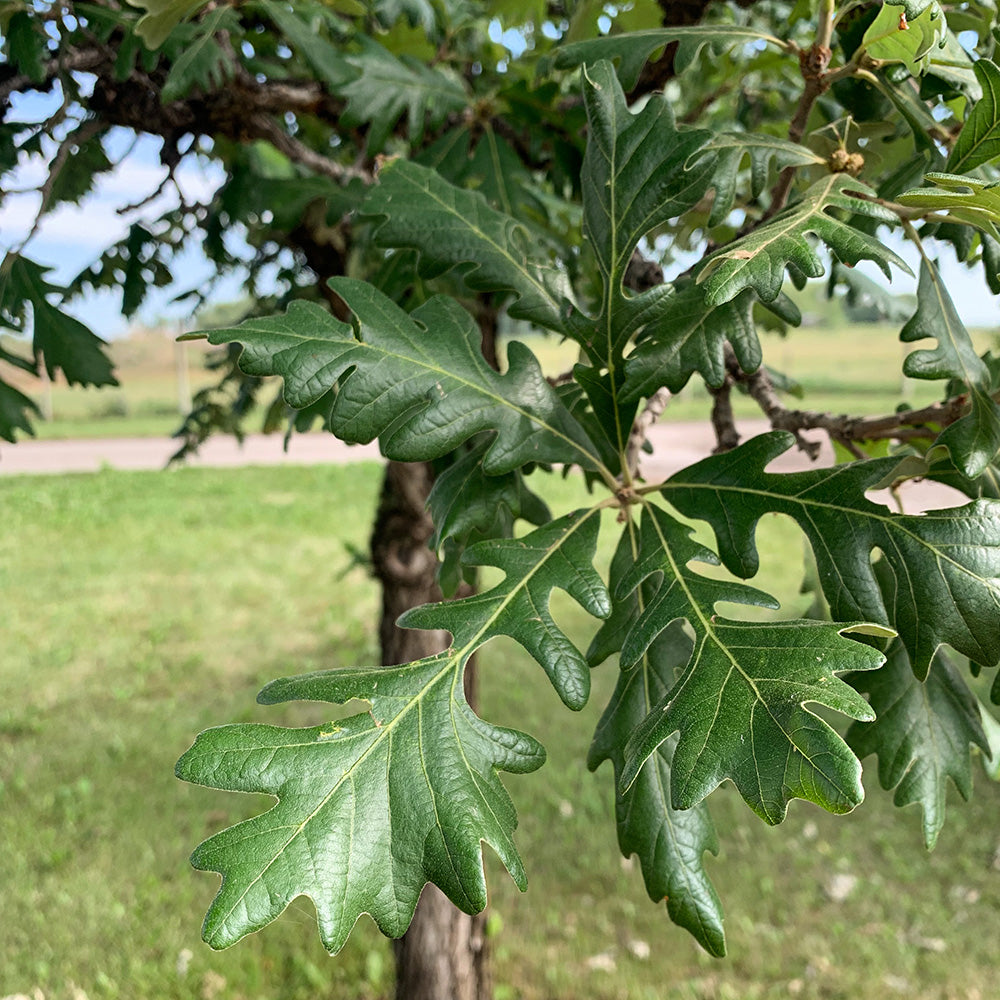Riverdene Garden Center
Bur Oak
Bur Oak
Couldn't load pickup availability
Quercus macrocarpa
Bur Oak is large, long-lived, and an extremely hardy deciduous tree native to North America. It is well-adapted to prairie climates and harsh winters, making it a great choice for Southwest Saskatchewan (Hardiness Zone 3). It is drought-tolerant once established, produces large acorns, and has a majestic, spreading canopy that provides excellent shade.
Planting & Location
- Hardiness Zone: 2-8
- Mature Size: 50-80 feet tall, 40-60 feet wide
- Growth Rate: Slow to moderate (12-24 inches per year)
- Lifespan: 200-300+ years (very long-lived)
- Sunlight Needs: Full sun (minimum 6 hours of direct sunlight)
-
Soil Preference:
- Tolerates a wide range of soils, including clay, loam, sandy, and rocky soils.
- Prefers well-draining soil, but adapts to moist and dry sites.
- Highly drought-tolerant once established.
- Can tolerate alkaline and slightly acidic soil (pH 5.5-8.0).
- Spacing: Plant at least 50 feet apart to accommodate mature canopy spread.
Watering
- Young Trees (First 2-3 Years): Deep water once per week to encourage root development.
- Established Trees: Extremely drought-tolerant; water only during extended dry periods.
- Winter Watering: If fall is dry, provide one last deep watering before freeze-up.
Fertilizing
- First Year: No fertilizer is needed—focus on root establishment.
-
Mature Trees:
- Apply slow-release fertilizer (e.g., 10-10-10) in early spring if growth is slow.
- Organic alternatives include compost or well-rotted manure applied as mulch.
- Avoid excessive nitrogen, as it can lead to weak wood growth.
Pruning & Maintenance
- Best Time to Prune: Late winter to early spring (before buds break).
-
How to Prune:
- Remove dead, damaged, or crossing branches to improve structure.
- Maintain a strong central leader when young.
- Avoid heavy pruning in summer, as it can attract oak wilt disease (though less common in Canada).
- Acorns: Large acorns drop in fall; may require cleanup if planted near sidewalks or driveways.
Pest & Disease Management
Common Pests:
-
Oak Gall Wasps – Cause small, round growths (galls) on leaves and twigs.
- Solution: Generally harmless, no treatment needed.
-
Aphids – Can cause sticky honeydew on leaves.
- Solution: Encourage natural predators like ladybugs.
-
Borers (e.g., Two-lined Chestnut Borer) – Attack stressed trees.
- Solution: Keep trees healthy with proper watering and mulching.
Common Diseases:
-
Anthracnose – Fungal disease causing leaf spots and defoliation in wet springs.
- Solution: Improve air circulation; rake and remove fallen leaves.
-
Oak Wilt (rare in Canada but possible) – A deadly vascular disease.
- Solution: Avoid pruning in summer when beetles spread the disease.
-
Powdery Mildew – White fungal coating on leaves.
- Solution: Improve air circulation and apply fungicide if necessary.
Winter Protection
- Young Trees: Wrap trunks with tree guards or burlap in winter to prevent sunscald and frost cracks.
- Mulching: Apply 2-4 inches of mulch around the base (keep away from the trunk) to insulate roots from extreme cold.
- Deer & Rodents: Protect young trees from browsing with tree guards or fencing.
Landscape Uses
Majestic shade tree for large yards and parks
Extremely hardy—thrives in harsh prairie conditions
Drought-tolerant once established
Long-lived—provides beauty for generations
Supports wildlife—acorns feed birds, squirrels, and deer
Resistant to strong winds—great for shelterbelts
Additional Notes:
- Bur Oak is one of the best large trees for the Canadian prairies due to its extreme resilience.
- It is a slow grower but worth the wait for its majestic canopy and hardiness.
- Works well in windbreaks, shelterbelts, or as a stand-alone specimen tree.
Photo courtesy of Foothills Nursery
Share


